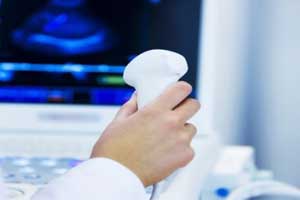- Home
- Editorial
- News
- Practice Guidelines
- Anesthesiology Guidelines
- Cancer Guidelines
- Cardiac Sciences Guidelines
- Critical Care Guidelines
- Dentistry Guidelines
- Dermatology Guidelines
- Diabetes and Endo Guidelines
- Diagnostics Guidelines
- ENT Guidelines
- Featured Practice Guidelines
- Gastroenterology Guidelines
- Geriatrics Guidelines
- Medicine Guidelines
- Nephrology Guidelines
- Neurosciences Guidelines
- Obs and Gynae Guidelines
- Ophthalmology Guidelines
- Orthopaedics Guidelines
- Paediatrics Guidelines
- Psychiatry Guidelines
- Pulmonology Guidelines
- Radiology Guidelines
- Surgery Guidelines
- Urology Guidelines
Ultrasound within 1 hour of ICU admission confirms type of shock

Ultrasound carried out within 1 hour of admission to the ICU plays a major role in the correct diagnosis of the type of shock and subsequent patient management, reports a study published in the Journal of The Association of Physicians of India.
The best ultrasonographic predictors for diagnosis of each type of shock can help the clinician to start timely specific interventions in critical care settings for each type of shock.
Shock is one of the leading causes of death worldwide. The fundamental approach to management, therefore, is to recognize overt and impending shock in a timely fashion and to intervene urgently to restore perfusion. Evaluation of a patient in shock can be challenging owing to its complex pathophysiology and the spectrum of overlapping clinical findings.
Tanvi Vaidya and associates conducted a prospective study to classify shock, using ultrasonography as the modality of choice for imaging and to assess the diagnostic accuracy of ultrasound as a tool to classify shock.
Bedside ultrasound examination was performed within 1 hour of admission to the ICU. These patients were also evaluated clinically and biochemically to confirm the type of shock. All patients immediately received standard diagnostic emergent interventions including physical examination, intravenous access for whole blood assays, arterial gas analysis, electrocardiography, continuous cardiac monitoring, supplemental oxygen, and chest radiograph. Clinical parameters, urine output, ECG and biochemical tests were performed within 12 hours of USG. Additional investigations were performed wherever required.
The ultrasonographic diagnoses were compared with the respective final clinical diagnoses by employing the Cohen kappa inter-rater coefficient of agreement. In addition, various ultrasound parameters were also analyzed to assess the best predictors for each type of shock.
The ultrasound diagnosis showed an overall good agreement with the final clinical diagnosis, in identifying the type of shock, in the emergency setting, when ultrasound was done within 1 hour after admission to the ICU.
In the study, ultrasound showed maximum sensitivity, specificity, negative and positive predictive values in the setting of obstructive shock. In addition, the perfect agreement was seen between the ultrasound and clinical diagnosis, with a Cohen kappa coefficient of 1 in obstructive shock. The least sensitivity, specificity, negative and positive predictive values of ultrasound were seen in the setting of distributive shock. Least agreement between the ultrasound and clinical diagnosis was also seen in distributive shock, as most ultrasound findings were found to overlap with those in the other types of shock.
Read Also: Wearable ultrasound patch monitors deep blood pressure
Based on ultrasonography findings, the investigators classified shock into 5 types as follows:
1.Hypovolemic:
Heart: Hyperkinetic left ventricle * Inferior vena cava: Collapsed IVC or IVC diameter < 1.5 cm with >50% collapse * Lungs: ‘A’ Profile Abdomen: Aortic aneurysm/Aortic dissection *- necessarily present.
2.Distributive:
Heart: Raised/decreased/normal EF. Inferior vena cava: Diameter < 2.5 cm. with > 50% collapse. Lungs: ‘A’ profile or ‘C’ profile. At least 2 of these signs must be present.
3.Cardiogenic:
Heart: Hypokinetic left ventricle* Inferior vena cava: 1.5-2.5 cm. or > 2.5 cm. with <50% collapse. Lungs: ‘B’ profile* Peripheral veins: normal. *- necessarily present.
4.Hypovolemic / Distributive shock:
Features of distributive shock Presence of free fluid- necessarily present.
5. Obstructive shock:
Heart: Cardiac tamponade / Right heart strain# IVC: <50% respiratory collapse and IVC diameter >2.5 cms.
“Our study also revealed how a combination of ultrasonographic findings can reliably predict the diagnosis of each type of shock in the emergency setting. Identification of the best predictors of each type of shock can help the radiologist and the intensivist to predict the type of shock and plan emergent interventions accordingly. This would significantly influence clinical decision making and have an invaluable role in the management of critically ill patients”, write the authors.
For reference log on to http://www.japi.org/august_2018/01_OA_Role%20of%20Ultrasound%20in%20Evaluation%20of%20Undifferentiated.html

Disclaimer: This site is primarily intended for healthcare professionals. Any content/information on this website does not replace the advice of medical and/or health professionals and should not be construed as medical/diagnostic advice/endorsement or prescription. Use of this site is subject to our terms of use, privacy policy, advertisement policy. © 2020 Minerva Medical Treatment Pvt Ltd